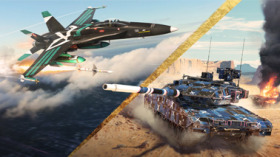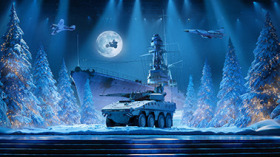
- For PC
- For MAC
- For Linux
- OS: Windows 10 (64 bit)
- Processor: Dual-Core 2.2 GHz
- Memory: 4GB
- Video Card: DirectX 11 level video card: AMD Radeon 77XX / NVIDIA GeForce GTX 660. The minimum supported resolution for the game is 720p.
- Network: Broadband Internet connection
- Hard Drive: 22.1 GB (Minimal client)
- OS: Windows 10/11 (64 bit)
- Processor: Intel Core i5 or Ryzen 5 3600 and better
- Memory: 16 GB and more
- Video Card: DirectX 11 level video card or higher and drivers: Nvidia GeForce 1060 and higher, Radeon RX 570 and higher
- Network: Broadband Internet connection
- Hard Drive: 62.2 GB (Full client)
- OS: Mac OS Big Sur 11.0 or newer
- Processor: Core i5, minimum 2.2GHz (Intel Xeon is not supported)
- Memory: 6 GB
- Video Card: Intel Iris Pro 5200 (Mac), or analog from AMD/Nvidia for Mac. Minimum supported resolution for the game is 720p with Metal support.
- Network: Broadband Internet connection
- Hard Drive: 22.1 GB (Minimal client)
- OS: Mac OS Big Sur 11.0 or newer
- Processor: Core i7 (Intel Xeon is not supported)
- Memory: 8 GB
- Video Card: Radeon Vega II or higher with Metal support.
- Network: Broadband Internet connection
- Hard Drive: 62.2 GB (Full client)
- OS: Most modern 64bit Linux distributions
- Processor: Dual-Core 2.4 GHz
- Memory: 4 GB
- Video Card: NVIDIA 660 with latest proprietary drivers (not older than 6 months) / similar AMD with latest proprietary drivers (not older than 6 months; the minimum supported resolution for the game is 720p) with Vulkan support.
- Network: Broadband Internet connection
- Hard Drive: 22.1 GB (Minimal client)
- OS: Ubuntu 20.04 64bit
- Processor: Intel Core i7
- Memory: 16 GB
- Video Card: NVIDIA 1060 with latest proprietary drivers (not older than 6 months) / similar AMD (Radeon RX 570) with latest proprietary drivers (not older than 6 months) with Vulkan support.
- Network: Broadband Internet connection
- Hard Drive: 62.2 GB (Full client)

From 15:00 GMT 4th of June to 15:00 GMT 5th of June
30% on SL gain in the [Special] Midway (RB and SB)
34% discount on the purchase of advanced set "Pacific Ocean"
This package includes the XP-38G aircraft and A6M5 Ko, two single-player campaign "Pacific campaign for the U.S. (1941-1943) and" The Pacific Campaign for Japan (1941-1943) ", month premium account and 5000 Golden Eagles.
Taking its name from lying roughly at the midpoint between Asia and North American, Midway Island was of great strategic significance as a staging area for military forces. A Japanese plan to invade the US held Midway Island was accelerated by the impact of the Doolittle Raid, although elements of Japanese Command voiced a preference to isolate and neutralize Australia first.
The Japanese plan was to lure the US Pacific Fleet out and into combat where it would be destroyed by the forces of the Imperial Japanese Navy. Vice Admiral Chuichi Nagumo’s First Air Fleet would support an amphibious assault against the island whilst the majority of the Japanese force would fall under the command of Admiral Yamamoto, some 300 miles behind Nagumo’s force. Simultaneously, a plan was drawn up for an attack against the Aleutians. Many officers involved in the execution of the plan objected to its complexity and the lack of experienced aircrew, but they were overruled. The main carrier strike force of six Japanese aircraft carriers – two destined for the Aleutians - set sail in May 1942, completely oblivious to the fact that Japanese codes had been deciphered by US Naval Intelligence, and Admiral Nimitz was well aware of the entire plan.
|
The Japanese aircraft carrier Hiryu burning and sinking |
Ignoring the attacks on the Aleutians on June 3rd, the US Navy had concentrated its assets on and around Midway. Whilst the first wave of some 100 Japanese naval aircraft attacked Midway’s defences on June 4th, shore based aircraft of the US Navy and US Army Air Force struck the Japanese carriers, but with limited success thanks largely to the concentrated screens of AA fire and Zero fighters. A second wave of Japanese aircraft were being ranged on deck when a strike force of over 150 carrierborne US naval aircraft attacked.
The low flying American torpedo bombers were devastated by AA fire and Zeros with 35 of the 41 Douglas Devastators being shot down, but this allowed a clearer run for the Dauntless dive bombers. The carriers Akagi, Kaga and Soryu were set ablaze by accurate bombing from the US naval aviators, so much so that all three carriers had to be abandoned. The coordination of the attack was perfect – in just four minutes the Dauntless dive bombers had halved the Japanese aircraft carrier strength in the entire region.
 |
|
USS Yorktown (CV-5) is hit on the port side |
A retaliatory strike by Japanese carrier aircraft caused severe damage to the carrier USS Yorktown, which was struck by three 500 pound bombs dropped by the 8 D3A ‘Val’ bombers which managed to penetrate the defensive screen. Effective damage control and prompt action by the crew managed to save the stricken carrier, but a second strike delivered a further three bombs and two torpedo hits and Yorktown was abandoned. The desperate fighting between the two carrier forces continued when another American attack caught the carrier Hiryu preparing to launch its own strike force, together with aircraft which had survived from the other carriers. Dauntlesses from USS Enterprise and Hornet scored four direct hits and four near misses, setting fire to the aviation fuel supplies. At 0900 the next day, the Hiryu sank.
The Battle of Midway was fought from June 3rd to June 7th, but it was the desperate actions on June 4th which turned the tide of the Pacific War to favour the United States. The Japanese navy had lost 2280 men, 258 aircraft and four carriers. Midway is largely credited as the first major naval battle fought entirely by naval air power, and further proof that the aircraft carrier had now replaced the battleship as the chief weapon of a modern fleet.





